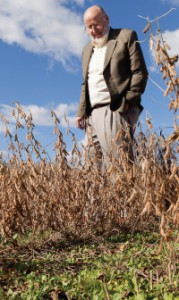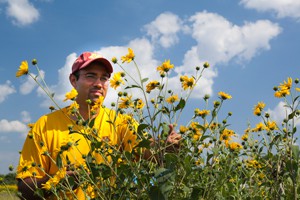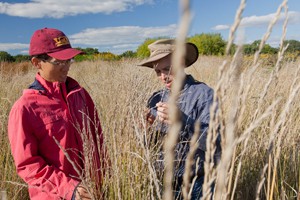By Julie Lund of the University of Minnesota’s College of Food, Agricultural and Natural Resources Sciences (CFANS). Posted on CFANS website: http://www.cfans.umn.edu/about/solutions/forever-green

Don Wyse has been working with colleagues for nearly two decades to find and develop new alternative crops.
Minnesota has 27 million acres of farmland dominated by corn and soybeans. Over the years, as high-yield varieties were introduced, these food and feed crops edged out prairie and pastures, and the state’s agricultural landscape lost much of its biodiversity.
“There’s nothing wrong with corn or soybeans,” says Professor Don Wyse of the Department of Agronomy and Plant Genetics. “Over the last 75 years, the department has invested heavily in developing the wheat, corn, soybeans and barley that people were asking for. Because of their success these crops became the dominant crops in Minnesota agriculture.”
But, as summer annuals, those crops are active for only a few months, leaving fields brown much of the year. Without crops covering the land it is vulnerable to erosion, fertilizer runoff and loss of nutrients. These factors can lead to water contamination and the loss of nitrogen and other valuable soil components.
“Everyone blames the farmers. ‘Why don’t they change?’ ” Wyse says. “But you can’t expect a farmer to turn away from corn and soybeans if there is no profitable alternative.”
Now Wyse and colleagues from across the college, the Agricultural Experiment Station and Extension are bringing together almost two decades of work in plant breeding, agronomy, conservation biology, food science and other fields to develop those alternatives—new crops that could make Minnesota’s cropland more productive, more efficient and more environmentally sustainable.
Grouped under the umbrella the “Forever Green Initiative,” this research could have a dramatic impact on the state’s economy and ecology. To accelerate progress, the state legislature recently appropriated $1 million toward the effort, with additional funding coming from state and federal agencies and Minnesota’s Discovery, Research and InnoVation Economy (MnDRIVE), a partnership between the university and state.
A systems approach: Building the basis for the bioeconomy
The hallmark of the Forever Green Initiative, according to Professor Nick Jordan of the Department of Agronomy and Plant Genetics, is a system approach.
“We are trying to bring together the development of new, high-value commodities with significant opportunities for conservation,” he says. But the new crops being developed are not just for the economic benefit of individual farmers. They also are intended to be the basis for whole new industries that will diversify rural economies and bring employment opportunities back to small towns.
This new approach involves advancing and achieving sustainable commercialization.
“Efforts to incentivize farmers to plant perennials and cover crops haven’t amounted to much in the past,” Jordan explains. “With Forever Green, there is a strong emphasis on addressing the economic barriers that have existed, as well as partnering with rural communities, policymakers and business to take a more holistic approach.”
Field pennycress: Extending the growing season
Research, conducted in part at the Southwest Research and Outreach Center in Lamberton and the Southern Research and Outreach Center in Waseca, has shown that rotating corn with soybeans increases yields for both crops, compared with growing either as a monoculture. Soybeans supply nitrogen to the soil, and corn thrives on that nutrient.
While this is good, Wyse and his research team think that farmers can do it one better by domesticating field pennycress—once considered a common weed—and introducing it as a relay crop into the corn and soybean rotation.
“Throughout Minnesota and the Midwest, there is nothing on the landscape between the time annual crops are harvested in the fall and the time that new plantings establish a canopy cover in June of the next year,” he explains. “That leaves a lot of bare fields for a lot of the year.”
Planting cover crops can reduce tillage and conserve soil by stemming erosion and nutrient loss, but many farmers find them too difficult to establish and hard to terminate when they don’t add to a farm’s profitability.
A relative of the mustard plant, field pennycress is a winter annual that can be planted in the fall. It survives over the winter and resumes growing in early spring, often before the snow has fully melted. Wyse has found that planting field pennycress amidst corn before it is harvested, then planting soybeans either in the pennycress in early May or following the pennycress harvest in mid-June, produces higher total yields than planting soybeans alone.
In addition to holding the soil and nutrients in place and filtering groundwater, field pennycress could be marketed as an oil seed crop. The most productive pennycress lines bred at the university are 40 percent oil by weight, with a composition that could be converted to biodiesel, aviation fuel or other industrial products. Wyse estimates that adding pennycress as a winter crop has the potential to add up to an extra $300 of profit per acre for soybean growers.
“If you want to change the landscape and add biodiversity, there has to be an economic benefit for the farmer,” says Wyse. In addition to profit, farmers also want the environmental benefits that pennycress provides—cleaner water, nutrient-rich soil and wildlife and pollinator habitat, among others.
Wyse and his colleagues will continue their breeding program to try to increase seed size, oil quality and other desirable traits, while also working on developing a market for pennycress seed oil.
“The research we’ve done thus far proves the concept of field pennycress as a value-added cover crop,” Wyse says. “Now it is moving toward commercialization.”
On the wild side: Adding perenniality to annual sunflowers

Post-doctoral researcher Michael Kantar is working to develop a perennial sunflower plant that creates both economic and ecological benefits.
Farmers grow annual sunflowers throughout the northwestern part of Minnesota, producing snack nuts and valuable seed oil that can be used in trans-fat-free cooking oil. But, like corn and soybeans, annual sunflowers produce only one crop per year, leaving the soil vulnerable to erosion and nutrient loss after harvest.
One Forever Green research team is trying to develop a perennial sunflower that would be equally productive and profitable as current commercial varieties and also provide important environmental benefits.
The idea, says post-doctoral researcher Michael Kantar (’06–B.S.; ’08–M.S.; ’13–Ph.D., Applied Plant Science), is to have agricultural production more closely mimic natural ecosystems and the prairie that cropland replaced. A key characteristic of native Midwestern prairies is the number and variety of perennial plants, which have extensive root systems that reach deeper for water and nutrients than those of annuals and better withstand drought and climate variations. They also are active more days of the year and provide ground cover, soil protection and wildlife habitat when dormant.
“Obviously, there are clear direct benefits from production agriculture: food, fodder, energy,” Kantar says. “But there are a lot of valuable things that natural landscapes offer, what we call ecosystem services. These are such things as biodiversity, aesthetic beauty, soil retention and water quality.”
The challenge, says Kantar, is to develop plants that are profitable for farmers and also deliver these ecosystem services.
And it is a challenge, according to plant geneticist Associate Professor Bob Stupar of the Department of Agronomy and Plant Genetics.
“The domestic sunflower has 17 chromosomes, while the wild perennial species that we are using has 51 chromosomes. That difference presents a real obstacle. [During breeding] there’s a genetic battle going on between the domestic and native traits. It’s been hard to optimize the process to get the perfect traits together,” he says.
Now, new DNA marker technologies are making it quicker, easier and cheaper for breeders to identify important genes and combine them in different configurations to produce better crops. Kantar and others are looking at the genetics that underlie winter survival in perennial sunflowers to add this trait to existing commercially successful annual varieties.
“These new molecular technologies have dramatically reduced costs,” explains Kantar, “while greatly improving our understanding of genomic material. We can target our experiments and test our hypotheses empirically right away. That wasn’t possible a few years ago.”
“In the past, domesticating a plant could take thousands of years,” agrees Stupar. “Now, the question is, can we take the knowledge about plant genetics that we’ve developed over the past 10 years and change the paradigm to make really rapid advancements?”
Kantar and Stupar think they can.
Intermediate wheatgrass: Student and industry interest fuel research

Research associate Xiaofei Zhang and agronomy professor Jim Anderson are part of the team working on a perennial wheatgrass variety that could give wheat growers additional options.
Many new plant breeds face a chicken-and-egg dilemma: what if you develop a fantastic plant that has no market and, therefore, no one will grow it? What if, on the other hand, there is market demand for a crop that does not yet exist?Researchers working on the development of perennial intermediate wheatgrass (IWG) are trying to tackle both questions at the same time.
Although his primary area of research is spring wheat, Professor Jim Anderson of the Department of Agronomy and Plant Genetics joined the research effort on IWG because he wanted to “see growers have other options.”
The Land Institute in Salina, Kan., has had an IWG breeding program since the 1990s. The university’s first IWG research plots were planted in 2010 on the St. Paul campus and at the Southern Research and Outreach Center in Waseca. Anderson and his colleagues are mapping the genes that produce greater seed size, bigger yields and a shortened stature so that the wheat stalk will stand up until harvest.
Seed growers seem fairly excited about IWG’s prospects, says Anderson. So do students. “There is more interest among graduate students in sustainable crops, like intermediate wheatgrass and pennycress, than there is in spring wheat,” Anderson says.
Food companies share that interest, according to Associate Professor Baraem (Pam) Ismail of the Department of Food Science and Nutrition. “Food companies are interested in producing products made from sustainable resources because consumers are interested in those products.”
Ismail and her research team are conducting chemical analyses of IWG to examine nutrient composition, including fat, gluten proteins and starch, among other characteristics. In some ways the new wheat varieties produce flour that is similar to conventional flour, but there are some significant differences as well.
“Gluten protein is what gives dough its elasticity, and the protein quality is quite different in IWG,” she notes. The new plants also have smaller seeds, resulting in a higher bran-to-endosperm (the “insides” of the wheat kernel) ratio. More bran and germ compared to endosperm means more fiber and enzymes, which can affect texture and flavor.
Baraem is experimenting making food with different proportions of IWG and regular wheat flour and will provide feedback to Anderson and other breeders, with the goal of producing flour that could be used, not just in baked goods, but also in nutrition bars, breakfast cereals and other products.
“The more of this wheatgrass that is used, the more farmers will want to grow it,” she says.
Some of the above ideas don’t make sense to me. Since corn and soybean are GMO crops, would the pennycress also be GMO? Otherwise the penny cress would be killed off by the Round-Up being sprayed on the corn/soybeans. And why would the U be promoting this when increasing numbers of consumers are trying to go GMO free?
When one sees the mass amount of cars in rush hour traffic, etc., how is it foreseeable to run this fleet on biofuels?
And if increasing numbers of people are gluten sensitive, what is the purpose of growing high-gluten wheat?
It looks to me like the University is going to use tax-payer money to fund projects that are destined to fail.